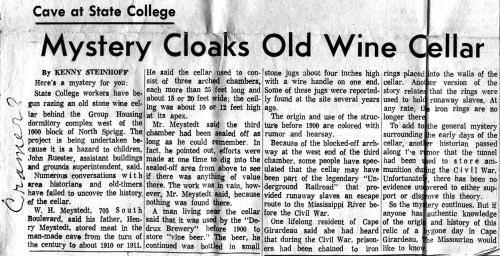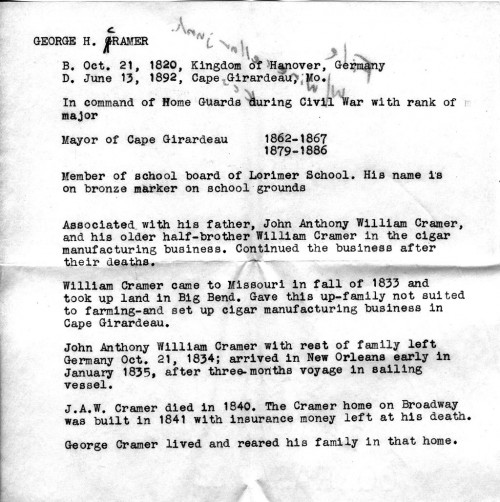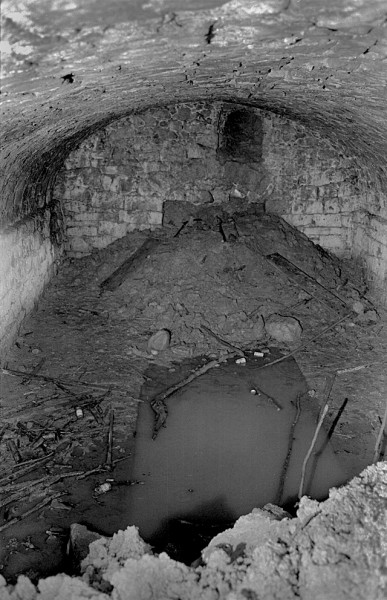 No wonder the North Sprigg Street wine / beer cellar jangled the memory bells yesterday: I WROTE The Missourian story about it.
No wonder the North Sprigg Street wine / beer cellar jangled the memory bells yesterday: I WROTE The Missourian story about it.
Shy Reader did some snooping around and figured out why I couldn’t find the story: The Google Archive jumps from May 16 to June 6 and this story bylined “Kenny Steinhoff” ran May 17, 1966.
John Blue must have edited this story and given me the byline. My official newspaper name was Kenneth L. Steinhoff; he probably slapped the “Kenny” on it and shipped it to the backshop to be set into lead type. Click on it to make it easier to read.
The Old Cramer Home
 One of the advantages of Old Tech is that you can scrawl notes on the side of the clip. This one had the question “Cramer?” written on it, which led Shy Reader to these notes about the Cramer family.
One of the advantages of Old Tech is that you can scrawl notes on the side of the clip. This one had the question “Cramer?” written on it, which led Shy Reader to these notes about the Cramer family.
What do we know about the cellar?
- It was behind the SEMO Group Housing complex west of the 1000 block of North Sprigg
- It was razed because it was a hazard to children
- W.H. Meystedt said his father, Henry Meystedt, stored meat in the man-made cave from the early 1900s to 1910 or 1911
- It consisted of three arched chambers, each more than 25 feet long and about 15 or 20 feet wide. It was 10 or 12 feet high at the apex.
- The third chamber had been sealed off. When it was dug into from the top, it was empty.
- Someone said that the cellar was used by the “Dedrux Brewery” before 1900 to store “vine beer.”
- The origin and use of the cellar before 1900 is colored with rumor and speculation, involving the legendary Underground Railroad tunnels, Civil War prisoners and a possible ammunition dump.
- “Kenny” Steinhoff asked if anyone who had authentic knowledge of the history of the relic of a bygone day to contact The Missourian, just like “Ken” Steinhoff did 45 years later.


Ken,
Could this be the old wine cellar of Michael Dittlinger? My Uncle, Albert Dittlinger talked about his family’s history of the property where the University is now located. He said in the 900 block just under Sprigg St hill was the old cave where his grandfather Michael has a cave for the wine from the grape vinyard located all along that area of the hills.
The house used for the Regent for years was built for his care takers. He told about playing all over that area as a child, so much history in Cape came from that family.
Could the Cramers have bought part of the old Dittlinger place?
My 3rd great grandfather was Michael dittlinger. They had wine from Germany there. Albert Alphonso dittlinger was my uncle. Laura dittlinger was my mom.
Ken, my family lived at 1000 N. Sprigg from the time I was in 3rd grade at Washington to my Junior year at Central. That cave was a great place for or sorts of kid activities. It was an especially great place to set off a cherry bomb or M80. We were never industrious enough to dig out to the next chamber but we always believed it was part of the underground railroad and lead all the way to the river. We would have dug it out and explored the passages to the river but we were afraid we would run into skeletons and SPIDERS.
As a Ute, i usulled to paly in thie area and dicovered the this Cave or wine cellar several times.
This was a pretty scary place as a ten year old and we did venture into it seveal times. The opening was large and light shown into almost the back on the chamber. We as kids did explore the “cave” and thought it was part of the underground railroad…Hey it was underground! and once even got a flash light to go all the was back to the back wall to see the openign to perhaps another room. At that time an adult from one of the houses on Spring yelled at us or maybe was yelling at something else and as youths in those days did when adults were displeased, we ran out and away toward the college to escape…. For some reason we never returned to further explore it…maybe beacuse the building in the area spooked us..or maybe we found other more interesting adventures in Cape.
I just read all the follow up articles to this post and wanted to answer Jeffry Boswell Hawks comment on the back cave like entrance under Wildwood. My Uncle Albert Dittlinger told me this was where the care takers had the wine press and they bottled the wine there when they had the winnery. They then stored the bottles of wine in the cave under what become Sprigg ST in that cave.
Later they used like a barn and kept the horse’s there, they used them to work the land after they stopped making wine.
Sprigg Road was just a rock road going out that direction until they poured the concrete street, that is when they sealed up the cave. The concrete street stopped at the top of the hill until then.
Interesting. Cape Girardeau has several stories of tunnels linkng buildings, caves and hollows to the river as part of the “Underground Railroad.”
The “Underground Railroad” was a network of secret routes and safe houses used by 19th-century black slaves in the United States to escape to free states and Canada with the aid of abolitionists and allies who were sympathetic to their cause.
The escape network was not literally underground nor a railroad. It was figuratively “underground” in the sense of being an underground resistance. It was known as a “railroad” by way of the use of rail terminology in the code. The Underground Railroad consisted of meeting points, secret routes, transportation, and safe houses and assistance provided by abolitionist sympathizers. Individuals were often organized in small, independent groups; this helped to maintain secrecy because individuals knew some connecting “stations” along the route but knew few details of their immediate area. Escaped slaves would move north along the route from one way station to the next.
We lived north of Bertling, but the “College Farm” was a playground and I remember the cave opening. Was this the cave that was called “Home of the Birds” or was that a different place?
Ken, The wine celler was built by Michael
Dittlinger when he came here around 1856. It was to the east side of Michaels home. It was one of the largest on the Mississippi River. They imported wines from France as GGGrandmother Marie Madeline Dore’ Dittlinger was from France. Wines were imported from Germany also as GGGrandfather Michael was German. They also made their own wine from the vast vineyards planted on their property. During the Civil War vineyards were destroyed as well as trees, orchards etc.